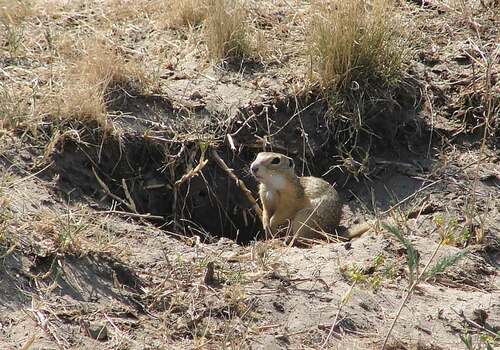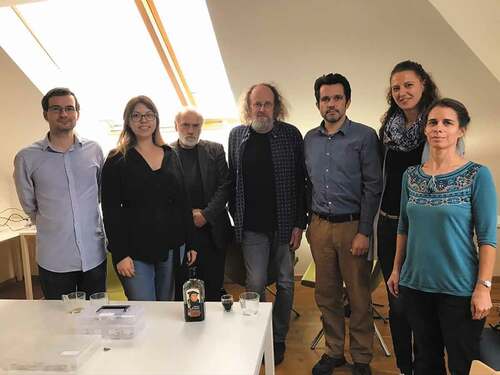The evolution of animal species in space and time belongs to the core questions of historical biology. In relevant studies on recent and fossil forms, three factors are always discussed to explain the observed differences: changing ecological conditions, palaeo(bio)geographical constraints on dispersal, and the evolutionary changes resulting from both. These three factors are closely interwoven.
In the framework of an INQUA-HABCOM project (abbreviation of: International Union for Quaternary Research – Humans and Biosphere Commission), we specifically studied ground squirrels, with respect to various aspects of their dispersal during the Quaternary, i.e. the time of the previous 2.6 million years: the influence of environmental conditions on species expansion and speciation, spatial relationships, interspecific competition, competitive exclusion and ways to avoid competition between species of the genus Spermophilus.
Why do we consider the rather inconspicuous ground squirrels (see ) to be particularly suited to answer the above questions? First, the dispersal dynamics of the Spermophilus species depends significantly on geographical barriers, which may well have changed over time. Such barriers must always be seen in connection with the ecological adaptations and the behaviour of the ground squirrels. This is particularly obvious in the case of the (in)ability to overcome water barriers. Here, ground squirrels are particularly restricted because they are not very good swimmers, and the crossing of frozen water surfaces in the winter is impossible since the animals hibernate in this time. On the other hand, events like the change of a river course or the emergence of isthmus open dispersal corridors for ground squirrels. Other characters of behaviour and biology of ground squirrels (burrowing lifestyle, social behaviour, hibernation and a strong interspecific competition) reinforce philopatry and restrict dispersal. With this in view, the influence of the environment on the distribution and speciation of Spermophilus would be relatively clear and easy to research.
Survival in an ecologically suboptimal environment is a common situation for a ground squirrel population when ecological conditions change in its range. Fossil ground squirrel remains allow important conclusions to be drawn from such studies: Their burrow taphocoenoses are usually completely autochthonous accumulations at a settlement site, unaffected by any transport. Thus, they can practically be regarded as palaeo-populations and they provide abundant material, in contrast to burrow taphocoenoses of non-social fossorial mammals. At the same time, their burrow taphocoenoses are part of loess and soil sequences, i.e. they are directly correlated with the loess and soil stratigraphy and the processes of soil formation.
At the workshop in Budapest 2018, which was part of our INQUA-HABCOM ground squirrel project 1606P, we received the generous offer to publish current results of our studies in Historical Biology as a special issue. Although the focus of our research was on Spermophilus, other animal species are of course also affected by the biogeographic corridors and barriers, since the same biogeographic filters apply to them. Ultimately, the conclusions drawn in one group can be verified in other ones. The unifying theme of the present issue is, therefore, palaeobiogeography and palaeogeography.
For the dispersal and spatial distribution of ground squirrel species, we had previously proposed a ’patchwork quilt’ model (Popova et al. Citation2019). This model considers two main types of range boundaries: First, so-called ’sub-meridional’ boundaries, which roughly correspond to geographical barriers (e.g. water barriers, mountain ridges). These boundaries are stable as long as the respective barrier exists. On the other hand, there are ’sub-parallel’ boundaries. These oscillate according to changes in climate and vegetation; that is, they are formed by climatically induced competitive exclusion.
The earliest case of such a competing pair of species with a ’sub-parallel’ boundary was the ground squirrel species Spermophilus praecox and S. polonicus, the earliest representatives of the genus in Europe (approx. 2 Ma BP). Popova, Nadachowski and Ulbricht (‘Expansion, speciation and a change of trophic niche: a case study of the Early Pleistocene ground squirrels Spermophilus polonicus and S. praecox’) have found big differences in their trophic niches and a high similarity of phylogenetically significant tooth characters. The probable way in which these species divided the adaptation zone was an expansion of the populations of S. praecox to the northwest during a general expansion of the steppe. After the respective ecological adaptations were acquired, the species neighbours simply ’guarded’ their sub-meridional border. Even if S. praecox would have migrated northwards during a climatic dry period, it would never have reached the physical limit of its tolerance and there would never have been in sympatry with S. polonicus because of the presence of this species and vice versa. Further details on how interspecies relationships of this type worked can be found in Zagorodniuk Citation2019 or in this volume in the article of Veklych and Popova (‘Lithologic features of near-surface layers of the Quaternary cover as a key to the understanding of environmental constraints for the Quaternary ground squirrel species’).
Far less clear is the relationship between the Central European ground squirrel species Spermophilus citelloides (fossil) and S. citellus (recent and fossil), which successively colonised the same areas. These species must have possessed ’sub-meridional’ range boundaries in the Late Pleistocene. However, there is no doubt that the ecological and phylogenetic relationships between these two species were different from those between the above-mentioned climatically controlled pairs of competitors. The work of Sinitsa et al. (‘Redescription and phylogenetic relationships of Spermophilus citelloides (Rodentia: Sciuridae: Xerinae), a ground squirrel from the Middle Pleistocene – Holocene of Central Europe’), convincingly demonstrates significant phylogenetic differences between S. citelloides and S. citellus. Both cranial and dental morphological distinguishing characters were used. This approach establishes the place of S. citelloides among other Spermophilus species, and may be generally recommended for further investigations on fossil ground squirrel.
The taxonomic determination of fossil species is one of the most important tasks of palaeontologists. As with most fossil rodents, tooth characteristics are used for this purpose in ground squirrels. Chemagina et al. investigated ’Ground squirrels of the genus Spermophilus from the Pleistocene and Holocene localities of the Middle and South Urals and Trans-Urals region: the dental features’. The dental characters were first examined on recent reference material, then on fossil Spermophilus species from the surrounding areas of the Ural Mountains. As a result of this analysis, similarities and peculiarities of the molars of the recent species were revealed and used to identify the fossil species.
In addition to classical morphological analyses, teeth are also suitable for rather new methods, such as geometric morphometrics or dental microwear. In palaeoecological reconstructions, palaeontologists, in a first step, begin with the requirements of closely related recent species. However, it must always be considered that the autecology of recent species may be completely different from that of fossil species. An example can be seen in the microwear study by Gusovsky and Sinitsa (‘Dietary preferences and autecology of a basal Holarctic ground squirrel Spermophilinus (Rodentia: Sciuridae: Xerinae), inferred from dental microwear analysis’). Their results suggest that the diet of the Late Miocene ground squirrels Spermophilinus bredai probably consisted of hard fruits and seeds, without signs of significant grass consumption or burrowing behaviour, suggesting feeding preferences that are most similar to those of the present-day tree squirrels of the genera Sciurus and Callosciurus.
The challenges of the periglacial environment and the way the species meets them are brought to our attention by the work of Stefaniak et al. (‘Diversity of muskox Ovibos moschatus Zimmermann, 1780 (Bovidae, Mammalia) in time and space based on cranial morphometry’). Their study of the morphological variability of muskox suggests an adaptive trend for Ovibos towards relative food flexibility, an increase in digested food quantity together with longer rumen retention time and lower relative metabolic rates. There is evidence of greater habitat fragmentation in Western Europe induced by the expansion of the Scandinavian ice sheet.
This leads to another important biogeographical/ecological factor: glaciations, which significantly influenced the spread of the Pleistocene fauna. Their extreme climatic influence is obvious. In addition, even for the most cold-tolerant species, there may have been an insulating effect caused by glacier tongues. In this volume, the impact of glaciations on the state of palaeogeographical environment is considered in two works, Ogar (’Carboniferous fauna from erratics at Hradyzk area (Poltava region, Ukraine): palaeo-ice streams indicator of the Dnipro Glacial Maximum’) and Ivanik et al. (‘Palaeogeography and neotectonics of Kaniv dislocations (Ukrainian Shield, Ukraine) in the Neogene-Quaternary period’). Their results suggest that the Dnieper glacier at the end of the Middle Pleistocene (MIS 8–6) caused even greater difficulties for the east–west faunal exchange of steppe small mammals than previously assumed.
Fossil krotovinas are an important key to the study of palaeopopulations and palaeobiology of fossorial rodents, including ground squirrels. The paper by Matviishyna and Kushnir (‘Climatic and landscape influences on the distribution and abundance of the Pleistocene small-mammal burrows of Ukraine’) summarises a large amount of factual data on fossil krotovinas obtained during palaeopedological studies. This work represents a synthesis of the general intensity of mammalian burrowing activity as a function of various environmental factors during the Late and Middle Pleistocene. The relationship between the optimal living conditions of digging small mammals and the composition of the upper part of the section is of particular interest to us.
The article of Veklych and Popova (‘Lithologic features of near-surface layers of the Quaternary cover as a key to understanding of environmental constraints for the Quaternary ground squirrel species’) aims at the edaphic factors also. The authors evaluate different types of subsoil with respect to the substrate preferences of ground squirrel species. They find a positive effect of loess accumulation on the Pleistocene population of ground squirrels.
Perhaps the most dramatic aspect of the relationship of Pleistocene ground squirrels with their environment – the role of rivers in the evolution of this animal group – is discussed in the paper of Sebe et al. (‘Quaternary evolution of the river Danube in the central Pannonian Basin and its possible role as an ecological barrier to the dispersal of ground squirrels’). For our research group, the Danube River was a challenge with respect to our ’patchwork quilt’ model. At least for the recent European ground squirrel, Spermophilus citellus, this great river is expected to have been a major dispersal barrier, but that is not the case. Sebe et al. show that rapid river course changes (avulsions) of the Danube ensured repeated gene exchange across the river for ground squirrels and other small mammal populations, thus maintaining genetic similarity between populations on opposite banks.
With the articles in this volume, some long-standing questions were answered, some came a step closer to being answered, but many more new questions arose. The spatial behaviour of mammalian species in response to the drastical palaeogeographic changes during the Quaternary is linked to profound evolutionary and ecological phenomena and offers a truly inexhaustible field of research.
Finally, we would like to remember our colleague Daria Chemagina (see ), who worked with us on the Spermophilus Project. She died unexpectedly after a short illness on 29 February 2020. Daria was a promising young scientist and a friendly person. All of us who knew her and worked with her will miss her very much.
Disclosure statement
No potential conflict of interest was reported by the authors.
References
- Popova LV, Maul LC, Zagorodniuk IV, Veklych YM, Shydlovskiy PS, Pogodina NV, Bondar K, Strukova TV, Parfitt SA. 2019. ‘Good fences make good neighbours’: concepts and records of range dynamics in ground squirrels and geographical barriers in the Pleistocene of the Circum-Black Sea area. Quaternary International. 509:103–120. doi:10.1016/j.quaint.2018.03.023.
- Zagorodniuk I. 2019. Close non-murid rodent species in the fauna of Ukraine: differences, biogeography, and ecomorphology. Theriologia Ukrainica. 17:8–27. doi:10.15407/pts2019.17.008


